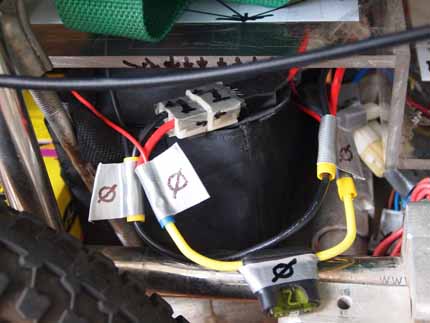Disabled Travel Tips for Airlines
Photo: Not the Boeing 787 Dreamliner, but a convenient (perhaps only) way to get around in lesser developed countries.
|
It is so important that we want to repeat what we suggested in the first section of this site: Whatever else you take, when you travel with disabilities, have documents that verify you are "special needs". Get a letter on a doctor's letterhead stationery stating you are disabled, need to have an electric scooter, require disposable paper goods- whatever. Get it certified or authenticated- and don't try to cheat or use forgeries.
|
Airlines and other organizations are aware many people can print their own "official" letters and forge the signature. Offices are now having special stamps made to avoid forgeries. Be sure to have them stamp your letter over the doctor's signature. |
Make several copies of the doctor's letter, all prescriptions, and any documents relating to issues where your condition may require special circumstances, equipment, parking considerations, or medication. Place a copy in each of your checked bags. |
If you have special equipment beyond the usual travel items, medical oxygen, assistive devices, some airlines will try to charge you extra shipping or excess weight fees. With the doctor's letter, these fees are usually waived. If they argue with you at check-in, politely and respectfully request a supervisor. If you hold your ground, they will relent, but the front desk person may not have the authority to change anything. |
Nancy travels with a special "Dune Buggy" wheelchair that is motorized, using Chinese electric bicycle wheel motors. Originally the wiring for these was enclosed, and the airlines regularly gave me a hard time about disconnecting the battery and all connections.
To solve this, I enclosed the wiring in a clear plastic container and put quick disconnects on all circuits. All the circuits are marked with the universal sign DO NOT, except #1, the main power circuit.

I also place advisory notes in English and whatever other languages will be spoken along our itinerary, pleading that no one to attempt touching the circuits. Upon arriving at the door to the plane, I disconnect the main power circuit in front of airline personnel and show them the power will not go on. I also tell an English speaking steward or stewardess to explain the cost and fragility of our wheelchair to the ground crew. Sometimes I will even slip a dollar or two to one of the crew who will be carrying Nancy's chair down to the loading bay. Be gentle, not commanding, in your tone and with your words. Make these people want to look out for you- not find some way to get back at you.

|
If you travel with complex electronic equipment, bring spare parts and a soldering gun with you. You will usually not find parts outside the US. On a trip back from Namibia, we discovered as we changed planes in Johannesburg that the electronics had literally been ripped out of the wheelchair. They even took a hammer and, using a screwdriver as a chisel, cut off the power lock. We were plain out of luck for the rest of the trip home, and the airlines ultimately reimbursed us a little over $4,000.00 for repairs and replacement of the electronics system.
|
We have also learned the hard way not to let the airlines take our chair at check-in, while they then transport us to the plane in their wheelchair. On landing at Schiphol in Amsterdam, we arrived at baggage claim and found our wheelchair lying on its side on the floor near the conveyer. I went over to set it upright and found they had bent the rear axel.
By shear luck, Schiphol is a maintenance hub for aircraft repair in Europe. We waited (more than two hours) while their chief engineer and head machinist came to look at the wheelchair. They took it into their shop and over the course of the next day and a half, handmade parts to repair the damage. We were fortunate, we "only" had to cancel one day's activities while the repairs were made.
|
Do not let the airlines load your wheelchair or scooter as "baggage". Insist you bring your equipment with you to the door of the plane, then have them hand load your wheelchair or scooter aboard. If you do this pleasantly and appreciatively, they will not give you too hard a time. |
Remember, it is easy for someone who is not disabled to assure you nothing will be a problem.
Go to next section of Travel Tips- Cruises (even if you are not planning a cruise, there is valuable information here). |
Please go to our Disabled Travelers Guide to the World for many additional tips on arranging tours, transport and other details. See, especially, Chapter 8- About Tour Guides. There is also valuable information in Chapter 12- About Bargaining and Negotiating. |
|
|
Have you checked the most important parts of our website? We urge you to go to the Chapter on Essential Plans. Then, whether they apply to you or not, read the Chapters Airlines, Cruises, Hotels, Taxis, Tours. Finally, be sure you read the Chapter Items to Take. The information in these chapters will make all the difference in the success of your trip. |
Contact Us
Please feel free to contact us if you have questions, suggestions, comments or just some friend words by clicking on our contact form |
